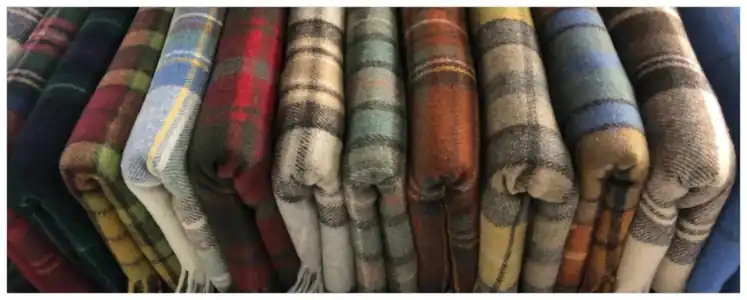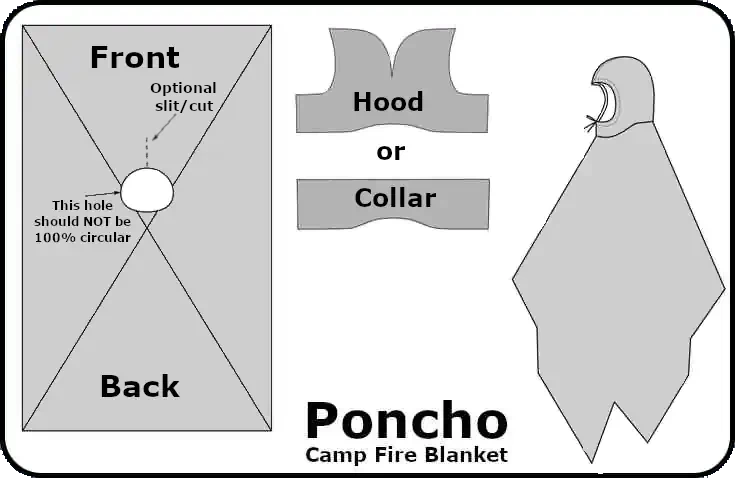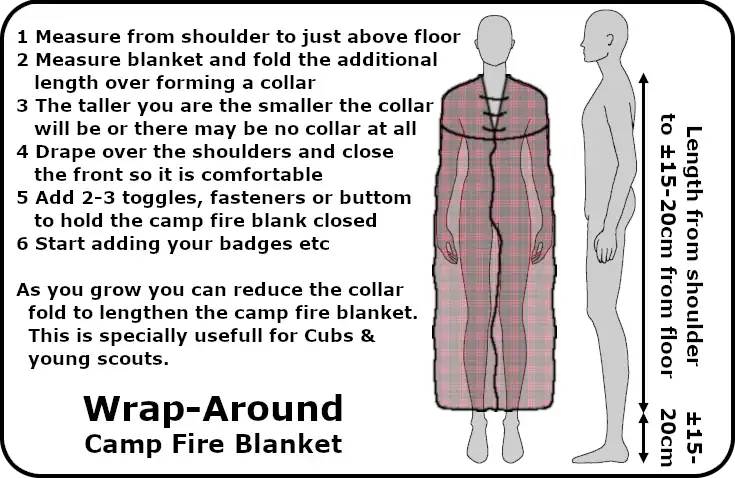Your Own Camp Fire Blanket
With a blanket on our shoulders, singing, dancing and talking; the campfire pops and crackles as you throw on another log, and a shower of sparks explodes into the night sky. You watch each drifting ember spiral upwards and die out, one by one, and feel the heat on your upturned face as the log catches, flames licking eagerly at the dry, seasoned wood.
This is a defining memory shared by many of us. This ritual is taken to another level with Cubs and Scouts whose uniform blankets are embellished with the badges of shared histories constituting a collective folklore with origins going as far back as Brown Sea in 1908 and the formation of the scouting movement and going centuries further back in many cultures.
The scout blankets stand as a sociological phenomenon and visual story book telling of your scouting experience memorialising, as the most impressive ones do, decades worth of camps, events and advancement badges going back many years to times of youth and young adolescence oft forgotten in the fog of time. Each badge, scarf or pennant is filled with memories, experience and detailed route map of childhood. They really are a sight to behold.
This is a defining memory shared by many of us. This ritual is taken to another level with Cubs and Scouts whose uniform blankets are embellished with the badges of shared histories constituting a collective folklore with origins going as far back as Brown Sea in 1908 and the formation of the scouting movement and going centuries further back in many cultures.
The scout blankets stand as a sociological phenomenon and visual story book telling of your scouting experience memorialising, as the most impressive ones do, decades worth of camps, events and advancement badges going back many years to times of youth and young adolescence oft forgotten in the fog of time. Each badge, scarf or pennant is filled with memories, experience and detailed route map of childhood. They really are a sight to behold.
"Sew your badges on to your Badge Blanket.
Drape it over your shoulders when it gets cool in the evening
or alternatively throw it over your sleeping bag on cold night."
Drape it over your shoulders when it gets cool in the evening
or alternatively throw it over your sleeping bag on cold night."
Blanket Selection & Choices
The materials a blanket is made of and how thick it is does affect the usefulness and durability of your camp fire blanket.The blanket you select should be durable, machine washable, not too heavy, fire resistant and most importantly not melt or set alight/burn easily. No blanket is fire proof but you also do not want your blanket to melt or burn at the slightest ember or flame, not only can it ruin your hard work but can also be dangerous.
- Basotho & Ndebele type wool blankets are great & make the nicest camp fire blankets
- Military surplus grey wool blankets are best as they are usually reasonably inexpensive & durable although usually only come in grey (you will cover it in badges!)
- Any wool blanket would be your best option and you do not need the most expensive one either but avoid fluffy blankets.
- 80%/20% Wool blends are cheaper than pure wool blankets and work well although not be as durable & water proof as pure wool but a very good option if you are unable to get a wool blanket
- Cotton & Cotton blend blankets are OK and usually light weight but are easily waterlogged and not as warm as you would like on a cold highveld winters' evening
- Pure synthetic blankets handle rain better and are lighter but are flammable & will melt which can be a safety concern around camp fires - Avoid as far as possible
Blanket Characteristics - the good and the bad
- Needs to be Fire resistance & almost a must - you will be around fire after all (such as wool & wool blends)
- Needs to be machine washable - it will smell like the favourite Scout cologne "Eau De Woodsmoke" and will need to washed regularily
- Needs to be durable - you put a lot effort and memories into your blanket and want it to last well beyond your Scouting years
- Avoid synthectic materials! They are easily damaged by flame & embers and may be a fire hazard resulting is serious burns as they melt into your skin when alight.
There are some synthetics that are fire resistant so if you are 200% sure, then ok but I would still avoid them. - Avoid fluffy blankets! - while usually very warm (when dry); they are painful to keep clean, a burr/bramble magnet, absorb water & damage easily around flames (fluff sets alight easily & quickly!).
They are also usually synthetic - see synthetics comment above! - Avoid fleece blankets. - they easily disform, especially when badges are sewn on & not very durable.
They are also usually synthetic - see synthetics comment above! - Avoid quilted down/hollow-fibre/etc blankets - they are really warm & usually reasonable water resistance BUT not very durable (you will sitting on it on rocks, ground, grass, abrasive surfaces) & susceptable to heat & flame damage.
They are also usually synthetic - see synthetics comment above!

Where to get blankets?
The sources of camp fire blankets are just as varied as their patterns and stories; so keep you eyes open and you may find one in the most unusual of places. Most people will opt to purchase a new off-the-shelf blanket and make their own camp fire blanket but there are other blanket sources too :)- Old blankets can be found in your grandparents' storerooom - ask before annexing it!
- Army surplus stores are a great place to find good quality military wool blankets.
At the writing of this page there is a fairly decent surplus store at 60 Charlotte Maxeke St, Pretoria West & army@armystores.co.za - Pep Stores (Shawl blankets - have nice designs too at reasonable prices)
- Online vendors (make sure to check what they are made of and the size!)
- For the artistic & industrious, you may even knit or crochet your own blanket (use a tight knit)
- Keep an eye out when travelling through our bueatiful country, there are many vendors that may just have your perfect blanket.
What size blanket should I buy?
That is a loaded question and depends entirely on what type of camp fire blanket you are wanting to make for yourself. In general:- Poncho designs : ±170x170cm or larger
- Over-shoulder designs: ±160x180cm or larger
- Full length, Cloak or jacket type designs: Depends on the pattern you are using
- The sizes are a guide only and you can use what you have or suits you
Blanket Styles
The first part of designing your perfect camp fire blanket is deciding what style you are wanting. In colder climates most people go for the "Poncho" design but it can be a little warm in our summers so in South Africa the "Over-Shoulder" or "Draped" design is more popular and also easier to make.Poncho style
- Usually made by taking a standard blanket and cutting a hole in the slightly forward of the middle so that it can be worn like a poncho.
- Start with a small oval'ish hole that is wider than it is long about the diameter the same as the linear distance (ie ruler straight & not curved around the head) from ear to ear.
- You can add a small cut down the front to allow the hole to expand when pulled over the head while to hole will still remain small and closely fit around your neck & shoulders.
A button may be added to keep the front "slit" closed - The "hole" needs to be reinforced by blanket stitch or by sewing on some binding tape.
- You can also add a collar or hood to your design as well. Old scarves make great collars! 🤩 😎
- The pocho pattern below is the straight version.
If your blanket is square, you have the option to make a V-shaped front version by turning the blanket 45° creating a V-shape front & back and the pattern below will still work; you just need to move the hole accordingly

Over Shoulder style
- Measure the distance from the nape of the neck at the back to the desired height from the ground.
- Try to keep the bottom hem at least 5-10cm off the ground; 20-30cm is usually more comfortable.
- Measure the blanket length and fold over the excess forming a "collar" or flap.
You can tack it in place if you want. - If the blanket has tassels, they should be at the bottom.
- Drap the folded end over the shoulders and pull it closed at the front.
- Find a comfortable height for a button, toggle or clasp and stitch one or three down the front.
- As you grow taller through your scouting career, you can let out the collar to lenghten the camp fire blanket
If you wan to keep the collar the same size, make the bottom hem bigger which you can let out as you grow.

Cloak style
These camp fire blankets are nice but a lot more work and require more than one blanket. Some have made then from their own designs but most will go hunting for a pattern to make their cloak style camp fire blanket. These are not for the novice or faint of heart!- Hooded cloak
- Monks robe
- Long cardigan
- Commercial trench coak (not truly a camp fire blanket & a bit of a cheat but it is your story)
I have my blanket - what now?
There is no write or wrong way to decorate your camp fire blanket; it is your story and you decide how you want to tell it and how much effort & artistic flair you put into your blanket. Here are some tips from those who have come before you and share their experience:- Sew your badges onto your blanket and do not glew them on! All glued badges will come off and leave a nasty mark on your blanket!
- There is no right or wrong way to decorate your blanket
- The badges & patches you sew onto your blanket do not need to be only scouting related! I have badges from holiday locations, places I have worked, charity organisations I support, badges I liked just because I liked them & anything I felt added to my story. You are the author of your story
- How you organise your badges is up to you!
- Chat to other blanket for inspiration!
- Remember, it is your blanket and your story!
Some Useful Links
- https://www.bestproducts.com/fitness/equipment/g18663279/warm-camping-backpacking-blankets/
- https://culdesacetcie.wordpress.com/2012/10/14/fire-camp-poncho/
- https://veravenus.com/diy-things-to-make-tutorials-patterns/cardigan-coat/
- https://www.instructables.com/Sew-a-Scout-Patch-Pancho/
- https://www.instructables.com/Sewing-a-JEDI-or-Harry-Potter-Robe-or-Cloak/ ✦ Very nice pattern
- https://www.fleecefun.com/how-to-make-a-hooded-blanket-free-pattern-adult-child/ ✦ Very nice pattern
- https://www.fleecefun.com/harry-potter-robe-pattern-free-diy/ ✦ Very nice pattern